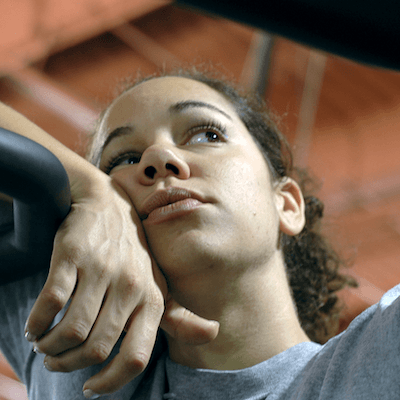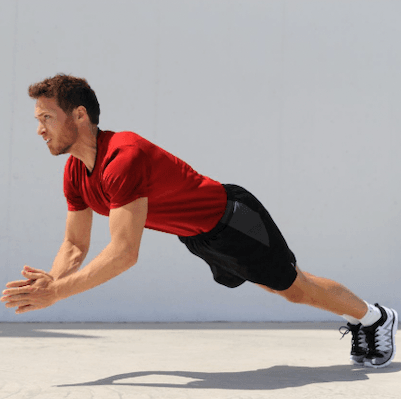


Dr Iain M Fletcher, PhD, SFHEA, ASCC and Dr Sean Maloney, PhD, ASCC, CSCS, University of Bedfordshire, Bedford
The general concept of the stretch and recoil of elastic tissue during ground contact – storing and releasing energy to enhance the propulsive phase of an action – is well understood. However, different stiffness measures are frequently used incorrectly and interchangeably, leading to ineffective monitoring of stiffness changes, limiting the impact of training designed to enhance stiffness. The aim of this narrative review is to discuss how different structures react to ground contacts, how this behaviour can be modelled and how stiffness impacts performance.
Hill’s three-compartment model highlights the need for tendon compliance and muscle stiffness in efficient force generation. However, this does not really explain slow stretch shortening cycle (SSC) actions, where both muscle and tendon stretch and recoil. Different models are used to describe a body’s ground impact behaviour: these include the spring-mass model, which describes centre of mass movement, and the torsional spring model, which describes leg function, with three torsional springs representing the ankle, knee and hip. These models generally link an increase in stiffness to an increase in performance in high intensity action, with vertical stiffness a predictor of high intensity sporting actions, independent of sex, age or maturation. Leg stiffness initially increases with running velocity, before remaining constant at high running velocities. When joint function is reviewed, ankle stiffness is linked to fast SSC actions, with knee stiffness linked to slow SSC actions. It is concluded that different measures of stiffness should not be used interchangeably as different aspects of stiffness impact performance independently.
Coaches will recognise the concept of ‘stiffness’ as an integral component of performance, underpinning both high-speed and endurance motor abilities. For instance, the idea of performing plyometric actions with short ground contact times, with the body braced for impact to allow a bounce-like action through a stiff system, is well understood. However, we often lack the nuanced biomechanical understanding of stiffness necessary to fully grasp how it impacts human movement performance. For instance, a stiff structure with a slow rebound is of little use in enhancing performance, whereas a compliant system with rapid rebound may be helpful for propulsion. Therefore, an understanding of what stiffness in a human system actually encompasses is warranted.
Stiffness can be defined as the ‘the ability of an object to resist deformation in response to the application of force’.29 In the human body, this means that any structure which can resist force being applied to it and which responds to that force application will exhibit a level of stiffness. In reality, for most sport performers, this is usually ground reaction inputs, such as running, jumping and change of direction. Performers will stiffen biological systems to resist tissue deformation, unwanted joint movements and attempt to prevent postural collapse. This applied force will cause deformation (strain) in the direction force is applied. Positive strain refers to the elongation of a material under load, as seen in structures like muscle and tendon tissue. Conversely, negative strain occurs when structures are compressed under load, such as in bone and cartilage. Once the load is removed, biological materials typically return to their original state, assuming the stress does not exceed the material's elastic limit.
The prevailing consensus is that increased stiffness of the musculoskeletal system during ground contact optimises the conversion of potential energy, stored in the elastic components of the leg during eccentric lengthening, into kinetic energy released during concentric shortening.15 High levels of stiffness are therefore considered advantageous when the required impulse for a movement must occur within a very short time frame, such as during ground contact in maximum velocity running5 or change of direction (COD).46 Although the concept of elastic stretch and recoil in passive structures, particularly tendons, is well recognised in ground-based actions, human stiffness is a more complex phenomenon than this simplified model suggests.
In particular, the role of stiffness within human function is often poorly understood. There is frequent confusion with how stiffness is measured, with concepts such as joint, leg and vertical stiffness used incorrectly and interchangeably in research impacting coach understanding of these concepts. This has led to the misuse/simplification of models trying to explain tissue behaviour during ground impacts, leading to misunderstandings on how stiffness impacts different parameters of performance. This is important to any coach trying to modify stiffness as the function and training of stiffness within different structures, particularly the passive and active components of the muscular tendinous unit (MTU), is substantially different.
The aims of this initial review are to discuss how different structures react to ground contacts, how this behaviour can be modelled and how stiffness within human tissue and within these models actually impacts different performance capacities. Part 1 of this narrative review will provide a knowledge base for coaches, underpinned by a sound scientific rational; Part 2 will explore more nuanced training interventions and monitoring of stiffness adaptations.
An electronic database search of empirical research studies and review articles using Sport Discus, Web of Science and PubMed was carried out from October 10 to November 10, 2024. The search terms utilised included terms linked to stiffness in human locomotion, including ‘vertical stiffness’, ‘leg stiffness’, ‘joint stiffness’, ‘stiffness and performance’, ‘stiffness and injury’, ‘stiffness and training’, ‘stiffness measurement’, and ‘stiffness and stretch shortening cycles’. Articles were scanned initially via title and then abstract before relevant articles were included for this narrative review.
Hill’s three-compartment model (Figure 1) conceptualises the mechanical interaction between muscle, tendon, and fascicle components of the MTU, highlighting the importance of relative tendon compliance and muscle stiffness in efficient force generation. The model suggests that maximising tendon strain and recoil, while maintaining quasi-isometric behaviour of the muscle fascicles, allows the MTU to operate effectively across a range of movement demands. Research by Lai et al27,28 demonstrates that as running speed increases from jogging to sprinting, the contribution of tendon elastic strain energy in the ankle plantar flexors – specifically the soleus and gastrocnemius – rises markedly. This shift is facilitated by minimal shortening in muscle fascicles, allowing tendons to bear the majority of length changes within the MTU. This quasi-isometric muscle behaviour not only enhances force production by reducing shortening velocities, but also optimises the force-length relationship, yielding higher force outputs and economical energy use, as observed at higher running speeds. Therefore, the mechanical function of the tendon as a primary agent for length change within the MTU underscores the adaptive advantage of muscle stiffness, which prioritises tendon elasticity for efficient stretch-shortening cycle (SSC) mechanics. Indeed, this process is further enhanced by the gastrocs working concentrically upon ground contact, lengthening the Achilles tendon from the proximal as well as the distal end, ensuring as short a ground contact time as possible.
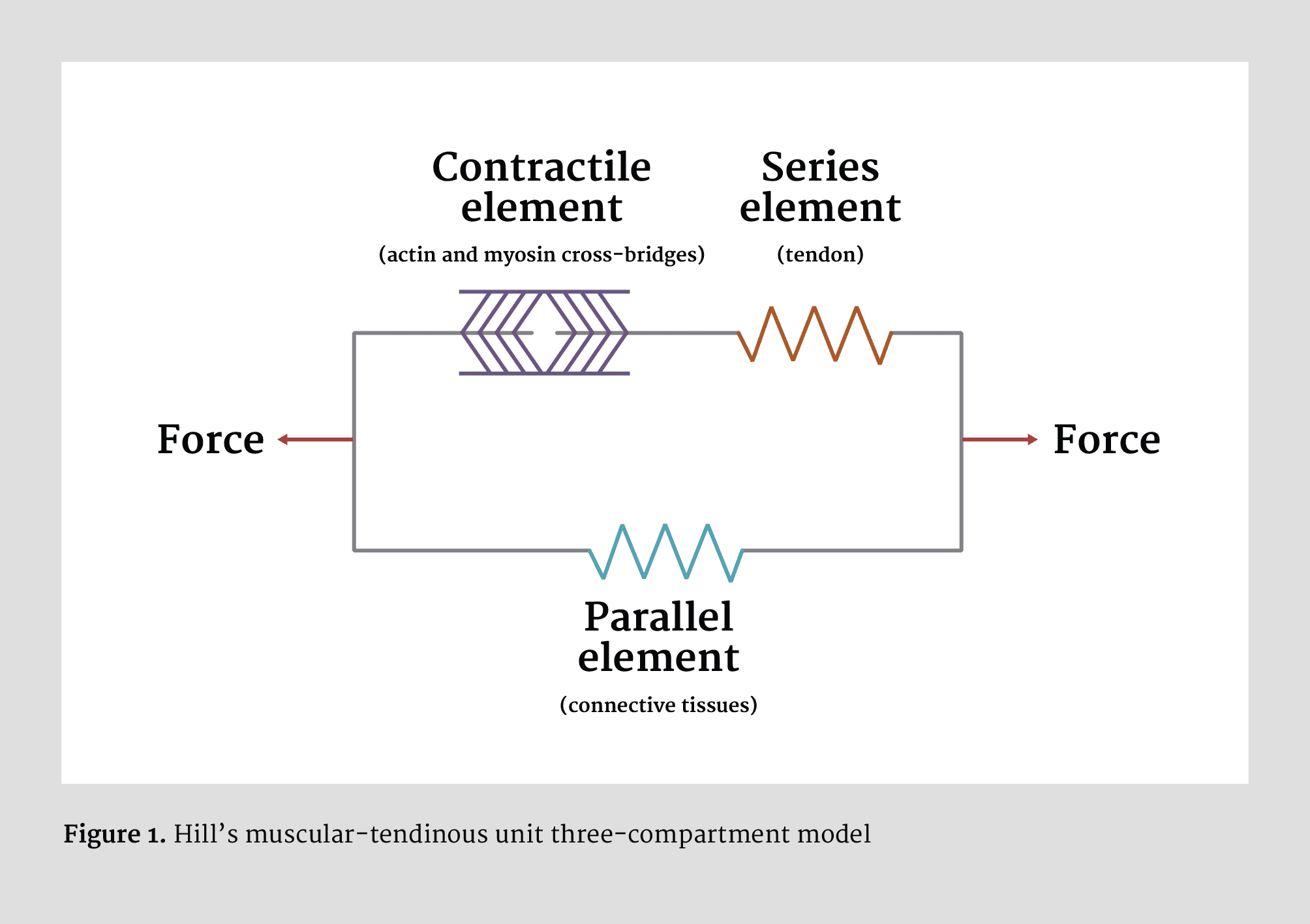
Hill’s model elegantly describes how an MTU behaves for efficient SSC function. However, it primarily applies to fast SSC actions, where potential energy storage and release are facilitated by a flight phase, such as in sprinting or drop jumps. These actions involve an impact event that enables energy storage and subsequent release, highlighting the critical role of stiffness in supporting effective quasi-isometric muscle action during ground contact. This mechanical model of the SSC should be considered alongside neurophysiological models, which may provide a more accurate explanation for slow SSC actions. Unlike the mechanical model, which emphasises energy storage and release, the neurophysiological model better accounts for actions like a countermovement jump or the initial phases of acceleration.17 In the absence of a flight phase, these actions rely on a rapid stretch of both muscle and tendon, detected by muscle spindles, which triggers a forceful involuntary contraction of stretched muscle. This active stretch-shortening contraction is metabolically inefficient,17 but is required to overcome the body’s initial inertia before more efficient SSC actions can be implemented. Even though there is no impact event in this model, the requirement of stiffness to make this stretch contraction event as quick as possible is imperative. A detailed review of SSC function is beyond the scope of this review, but readers are pointed towards Groeber et al’s17 recent systematic review for further clarification.
During ground contact, myofilaments and sarcomeres undergo micro-level distortion, while at the macro level, bones compress joints deviate, and the whole leg and body yield in response to ground reaction forces.22,43 These structures deform collectively, storing and subsequently releasing energy33,21 to achieve a performance outcome (see Figure 2 for hierarchical model which makes up stiffness measures).
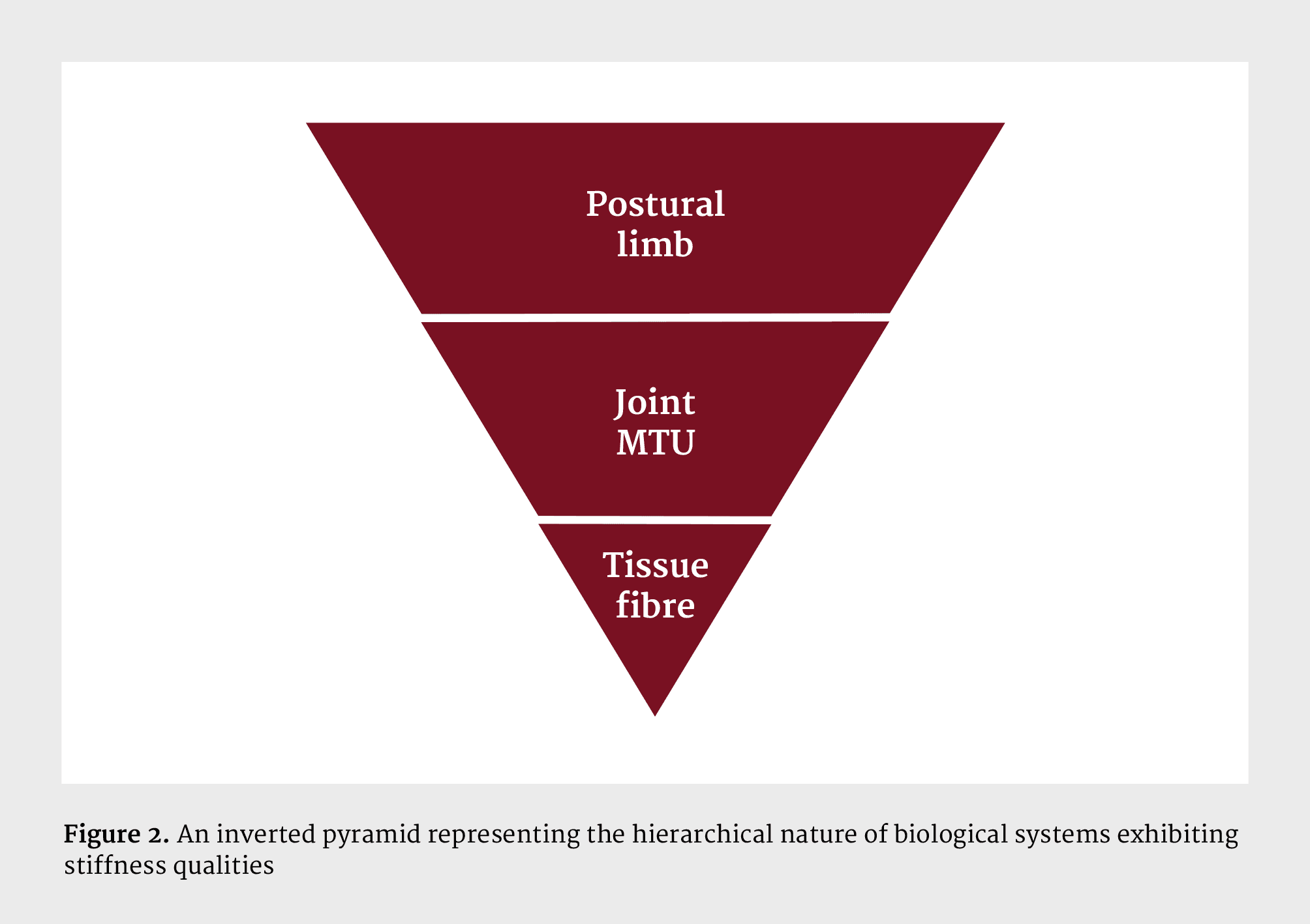
These structures can be grouped for more global measures of stiffness, with the most commonly cited measures being:
It should be noted that these three measures of stiffness are still global measures which are impacted by actual structural stiffness of individual components of a complex system. For instance, muscle microfilament and Achilles tendon stiffness can be measured, which will impact ankle joint stiffness, leg stiffness and in turn vertical stiffness. However, in order to measure tendon stiffness there is a requirement for ultrasonography, for elongation measures, synchronised with maximal torque output and tendon moment arm calculations. The complexity of this type of equipment and measurements is beyond the scope of most coaches and how useful the obtained measurements are to inform training programmes is questionable. Therefore, the choice of this review is to explore these three global measures in order to allow coaches to be able to appreciate the effects of stiffness on performance tasks that they may be able to measure, rather than an exploration of stiffness at the more micro level. Readers should also note that these measures are fundamentally different to each other and describe different behaviours of global structures.
At this point, it is useful to revisit Hill’s three compartment model, as it provides insight into some of the challenges in measuring stiffness. In this model, more compliant tissues can enhance the storage and utilisation of elastic energy during a SSC action.6 However, excessive compliance may prolong the ground contact (amortisation) phase, decreasing elastic energy return.48 This introduces the concept of optimal stiffness, although this idea may oversimplify the complexities involved. If we review ankle stiffness in running, the triceps surae functions quasi-isometrically during ground contact, with length change in the MTU the responsibility of the Achilles tendon.27 This demonstrates the necessity for muscle to act stiffly while the tendon remains compliant. Indeed, fundamental to Hill’s model is the concept that the active contractile component of the MTU has to be stiffer than the elastic component for efficient storage and release of energy during ground contact.
One of the problems with much of the literature in this area is that investigations have modelled stiffness using different methods, sampled a diverse range of performance measures and frequently used terms in an incorrect context – eg, using terms such as ‘vertical stiffness’ and ‘leg stiffness’ interchangeably. However, this article is not designed to be a critical review of past research, but aims instead to interpret past findings and explore their practical applications for coaches.
Stiffness of the whole body can be approximated using a simple spring-mass model.45 In this model, total body movement is represented as a point mass corresponding to the movement of the centre of mass (COM). Figure 3 shows the leg represented as a compressible spring supporting the mass of the whole body, influencing vertical movement of the COM. This model is commonly used to describe an individual’s interaction with the ground30 across various whole-body tasks, such as hopping, walking, running, COD, drop jumps and horizontal jumping.6

In this model, inadequate stiffness is associated with prolonged ground contact and decreased elastic return, resulting in decreased movement efficiency and impaired performance. Conversely, excessive stiffness is thought to limit the body’s ability to cope with impact forces, increasing the risk of both acute and chronic injury.34
Although useful for approximating the whole-body reaction to ground contact, the spring-mass model is overly simplistic in explaining how individual limbs and joints behave. It must be remembered that stiffness is a hierarchical system (Figure 2), where joint stiffness impacts leg stiffness, which collectively contributes to the summated COM movement. The leg does not function as a global spring-mass system; instead, individual joints act as torsional springs (Figure 4), each with distinct stiffness properties that contribute to stiffness characteristics of the whole limb.40
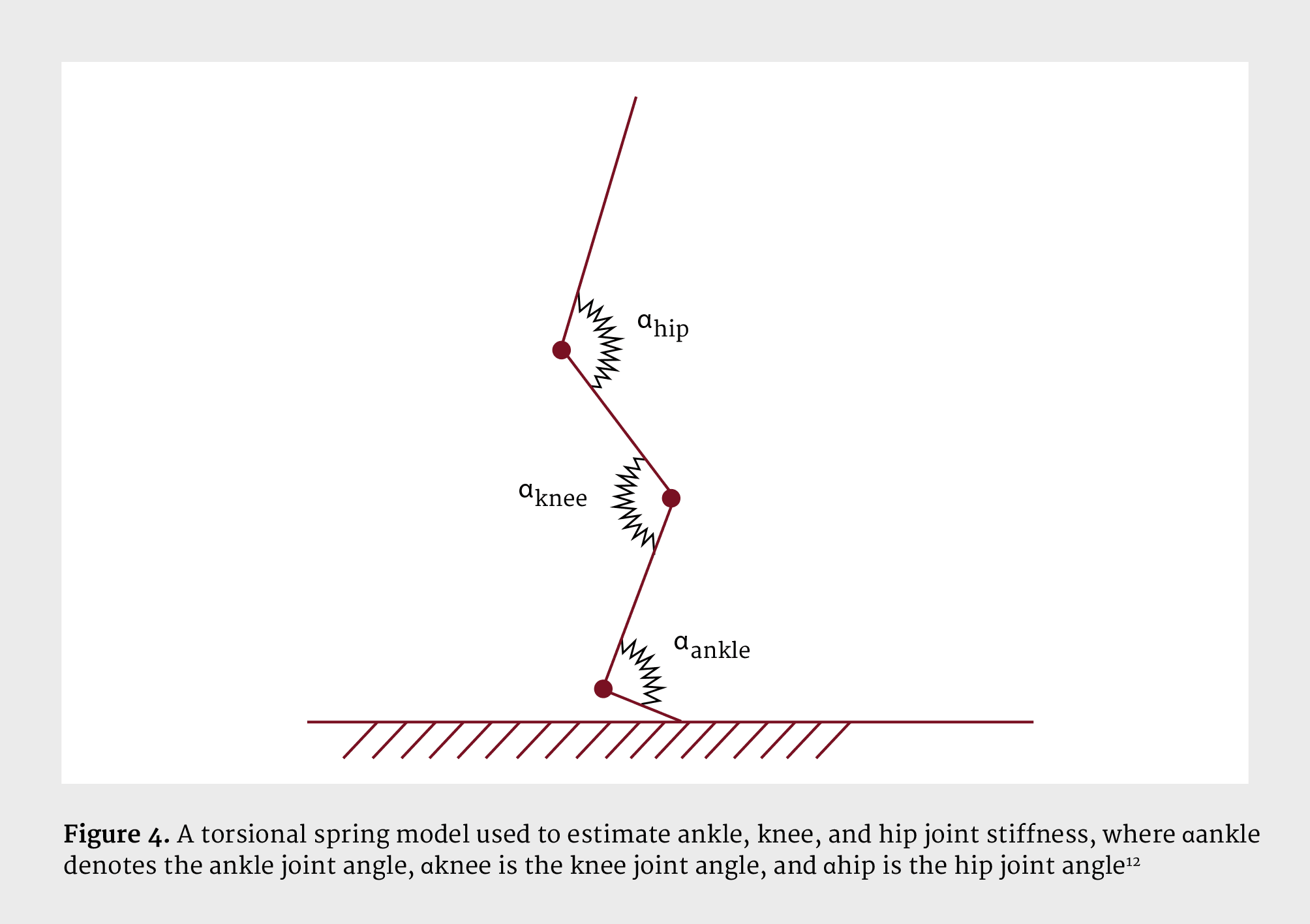
Farley et al12 conceptualised the lower limb as three torsional springs – the ankle, knee and hip – emphasising the importance of stiffness within each joint when evaluating leg stiffness or vertical stiffness. This framework enables exploration of strategies to optimise joint-specific stiffness for achieving an efficient leg spring. However, both the spring-mass and torsional spring models are inherently uniplanar, limiting their applicability to multiplanar tasks, such as COD/cutting actions, frequently seen in sport. Accurately analysing such tasks requires 3D motion capture, hence making a true measure of stiffness in multiplanar activities problematic and beyond the remit of many coaches. It should be emphasised that for these models to be utilised to calculate stiffness, the requirement for an impact event, force or torque applied to the system and length or angle change is an assumed requirement. Therefore, the use of tasks such as counter movement jumps without this information may imply a stiffer or more compliant system, but cannot be used for actual stiffness calculations. Part 2 of this review will explore how vertical, leg and joint stiffness can be measured, but for a detailed discussion of measurements and their limitations, readers are referred to Maloney & Fletcher’s33 critical review of lower limb stiffness testing.
This sub-section of this narrative review explores whether stiffness impacts performance, and how the various aspects of stiffness contribute to performance outcomes. At this point, it may be useful to review how stiffness is frequently measured in research, before a review of impact on performance is taken.
Stiffness describes the relationship between applied force and deformation of a given structure (Hooke’s Law). Therefore, there is a need for force and length change to measure stiffness. This is frequently explored using submaximal bilateral bounce jumps (described as ‘hopping’ in the literature) at a set frequency on a force plate, rather than the actual stiffness measure during a performance task due to the difficulty in estimating GRF during these tasks. During gross human movements, such as running, jumping and COD, the body is required to function as an integrated unit.40 With this in mind, it is not surprising that research in the area has concentrated on more global measures of stiffness, such as vertical and leg stiffness.
In coaching circles, the general consensus is that increased vertical stiffness is linked to better performance in high intensity actions. This has been shown in sprint-trained athletes compared to distance runners, with a 15% greater vertical stiffness for sprint athletes18 and greater in distance runners compared to untrained participants with >25% increase in vertical stiffness for endurance athletes.20 It is thought these findings are due to the need for faster running velocities requiring greater vertical stiffness to cope with increased vertical forces necessary as running velocity increases.6 Therefore, sprint-trained athletes develop the ability to generate greater levels of vertical stiffness due to coping with greater impact force applied to them and the need to produce greater propulsive force than distance runners, who in turn develop greater stiffness compared to the untrained for the same reason. However, an understanding of how stiffness was measured in these studies provides valuable context rather than an uncritical acceptance of their findings. Hobara et al18 measured vertical stiffness at 1.5 and 3Hz bilateral hopping frequencies, whereas another study by Hobara et al20 used a 2.2 Hz hopping frequency. However, neither study measured vertical stiffness during running or in a maximal task more representative of sprinting. Therefore, it remains unclear whether these findings apply to unilateral performance tasks rather than sub maximal bilateral tasks.
Vertical stiffness seems to be a predictor of high intensity sporting actions. Bret et al5 examined 100m sprinters' performances and showed increases in vertical stiffness predicted 30-60m and 60-100m performance, but not overall 100m performance. This is interesting as 30-60m performance is typically categorised by fast SSC usage, whereas start and initial acceleration necessitate slower SSC actions. The potential shift in importance of stiffness between fast to slow SSC actions is explored later in this article. Bourdin et al4 demonstrated a correlation between vertical stiffness and season-best performances in male national-level throwers in track and field. Additionally, vertical stiffness in trained males has been identified as a strong predictor of COD performance (90° cut), with faster athletes exhibiting greater stiffness than slower performers.32 Interestingly, the stiffness assessments in these papers used maximal bilateral hop or drop jump protocols, which are more intense and closer to the demands of athletic performance than the fixed-frequency hopping methods previously discussed. This alignment with sport-specific intensity strengthens the evidence supporting a potential link between increased vertical stiffness and enhanced performance.
The relationship between vertical stiffness and performance appears consistent across sexes. Although much of the existing literature focuses on male performers, Pruyn et al41 compared high stiffness and low stiffness groups of female netballers. They reported that the stiffer group had superior 10m sprint, squat jump, countermovement jump and drop jump performances. This research group has also shown elite netballers have greater vertical stiffness than sub-elite players.42
Age of performers has also been explored in relation to stiffness and performance. Rumpf et al44 found greater vertical and leg stiffness comparing males at different stages of maturation. For example, vertical stiffness was 21% greater in post-peak height velocity (PHV) compared to mid-PHV, and 30% greater in mid-PHV compared to pre-PHV. The general trend of increased performance and increased stiffness with age is further supported by Beerse & Wu,3 who showed children (5-11 yrs of age) had vertical stiffness measuring 20% lower than young adults due to more centre of mass deformation. Again, there is a caveat with this research, as stiffness was measured via submaximal hopping tasks rather than actual performance tasks.
With ageing performers, a similar pattern is seen; master endurance runners (aged 63) had 27.8% lower vertical stiffness compared to younger runners (aged 27), mirrored by reductions in performance.39 Interestingly, stiffness was measured using a bilateral hopping task; when vertical and leg stiffness was measured in running, no differences between groups was found. This is possibly due to the complexity of running coordination compared to bilateral hopping, which could diminish the potential effect of any structural reduction in stiffness of biological tissue with age. It may highlight the importance of task specificity when trying to look at stiffness measures and actual task performance.
Initial research on exercise intensity and stiffness supports the idea of increased vertical stiffness with higher exercise intensity. However, this initial work showed links between increased vertical stiffness and higher bilateral hopping frequencies,11 a pattern corroborated when examining leg stiffness.23 This association is less clear, however, when actual performance tasks are explored. Arampatzis et al1 showed an increase in vertical and leg stiffness with increases in running velocity from 2.5-6.5 m·s-1, a finding supported at higher intensities in the trained sprinters explored by Kuitunen et al.26 The latter study reported a 66% increase in vertical stiffness when comparing 70% and maximum running velocities (9.23-10.26 m·s-1).
Similar trends have been reported in recreational athletes,37 but such relationships are less consistent in elite performers. Clarke & Weyand9 found no relationship between stiffness and performance in elite sprinters, likely due to individual differences in stiffness in this comparatively homogeneous group. These individual differences in elite performers were highlighted by Taylor and Beneke,47 who analysed the 2009 World Championship 100m final. Usain Bolt posted the fastest time and highest maximal velocity, but exhibited 52% and 28% less vertical stiffness compared to Tyson Gay and Asafa Powell. Therefore, though increased stiffness may be generally related to increases in performance, individual differences within elite populations are apparent and need to be examined further for a full understanding of individual responses to changes in stiffness. It must be remembered that these high-level sprinters are required to employ complex coordination patterns, where the timing and direction of force application in the context-specific skill of sprinting is imperative. They will show a greater vertical stiffness compared to sub-elite performers, but within their peer group it may be the application of stiffness which differentiates such high-level performers.
A further caveat when looking at stiffness and running velocity may be apparent. Vertical stiffness seems to increase with running velocity, but leg stiffness seems to remain constant after initial increases at lower running velocities,8,36 which may have implications for both the measurement and training of stiffness for high-speed actions.
Reviewing the role of joint stiffness in performance helps to identify which joints provide the greatest contribution to overall system stiffness. For instance, it would seem that the ankle and knee are most relevant when looking at vertical stiffness, as hip displacement is limited.31 During bilateral hopping tasks, it seems the ankle is the primary determinant of vertical stiffness. Farley et al12 showed a 1.75-fold increase in ankle stiffness, corresponding with a 1.7-fold increase in vertical stiffness in hopping at 2.2 Hz. This was supported by Farley & Morgenroth13 showing a 1.9-fold increase in ankle stiffness, increasing vertical stiffness 2-fold at the same hopping frequency (2.2 Hz) for both preferred and max hopping height.
However, the intensity of tasks may impact the joint stiffness patterns. Hobara et al18 showed that an increase in knee stiffness was linked to slower hopping frequencies, with longer ground contacts and greater hopping heights, whereas increases in ankle stiffness were associated with faster hopping frequencies and shorter ground contact times. This pattern of response was supported by another study by Hobara et al,19 where knee stiffness was predictive of vertical stiffness when bilateral hopping for maximum height, with a comparatively long ground contact time.
The importance of ankle stiffness in maximal intensity, fast vertical actions appears consistent. For example, male decathletes performing drop jumps from heights of 0.2-0.6m exhibited a positive correlation between increased ankle stiffness and decreased ground contact time, whereas the knee stiffness showed no such relationship.2 It seems that if tasks need greater demand for active force production during the propulsive phase (slow SSC actions), such as starting and initial acceleration, they rely more on knee stiffness due to longer ground contacts and larger angular displacements. However, tasks reliant on passive redistribution of forces during ground contact (fast SSC actions), such as drop jumps and max velocity running, are more reliant on ankle stiffness due to shorter ground contacts and less angular displacement. This distinction highlights how the required propulsive impulse differs between slow and fast SSC tasks.
Figure 5 shows how slower tasks generate lower peak forces, but apply this over a longer time span to generate the impulse required to jump (eg, countermovement jump). The fast SSC (drop jump) has a higher peak force output, affording shorter contraction time to generate the required positive impulse. Interestingly, Kopper et al24 also showed that the slower action (CMJ) exhibited greater joint angular displacement and greater centre of mass displacement compared to a drop jump task. Figure 5 highlights this with the diagrammatic representation of the CMJ showing a large flexion/extension leg action, compared to the drop jump. The generation of large impulses in short time frames is indicative of a stiff system as demonstrated in Figure 5A, a drop jump. These concepts will be explored further in Part 2 of this review.
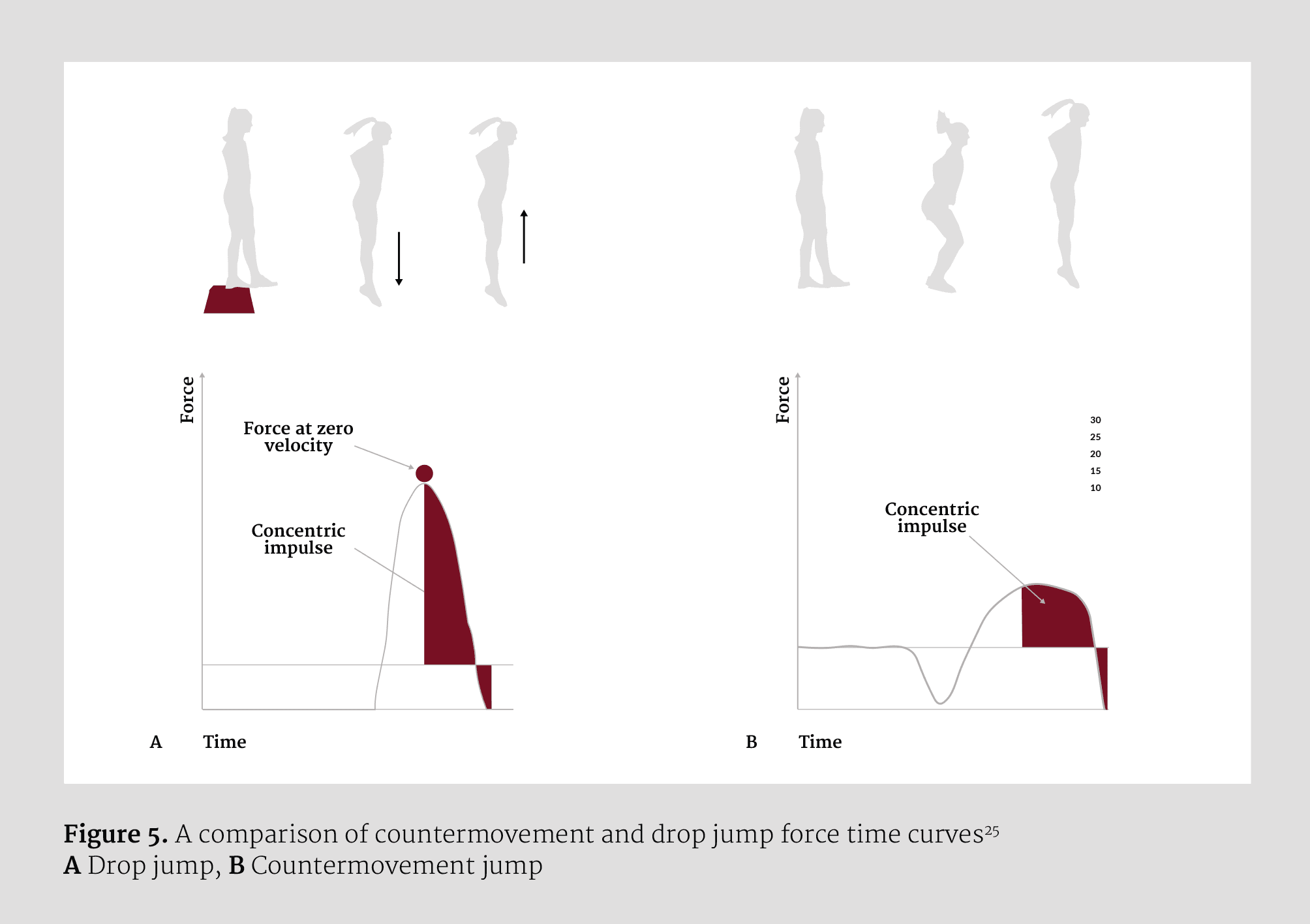
An exploration of performance is not complete unless injury risk is factored into the narrative. It is hypothesised that there is an increase in injury risk if GRF increases and/or the number of ground reaction events increases.34 It has therefore been assumed that increased stiffness of structures, linked to greater GRF, is linked to increased injury risk.7 As with many aspects of this review, the relationship between stiffness and injury risk is nuanced. Both high and low leg stiffness values demonstrate the potential to increase injury risk.7,33 High stiffness may be linked to an increased prevalence of bone and ligament injury risk, while low stiffness values may be linked to soft tissue injuries.33,38 If a performer is too stiff, GRFs may be transmitted quickly to bony structures causing a sudden ‘shock’ response that the structure has insufficient time to cope with.7,14 Conversely, a lack of stiffness may see musculotendinous structures repetitively stretched under load causing micro trauma as joints deviate excessively.
The potential stiffness response to loading brings up some interesting coaching prospectives. Should the performer be coached to adopt a stiffer strategy on landing – helping performance, but potentially increasing bone and connective tissue injury risk? Or should the performer be coached to adopt a softer landing strategy, which may decrease performance, help some aspects of injury prevalence, but possibly increase muscle micro trauma? Conversely, is the stiffness response naturally adopted by an athlete based on their physical capability – and therefore attempts to coach a stiffer strategy, which their tissue and control system may not have the ability to cope with, could be a potential injury risk? It is possible that the best method may be to allow performers to adopt their preferred strategy and then build capacities around this, allowing the athlete to naturally adopt a safer and more efficient stiffness response. For instance, a performer who adopts too soft a landing strategy is probably doing this as they lack strength to ‘stiffen’ structures on landing. Therefore, a strength intervention could lead to a more efficient stiffer landing strategy as strength levels increase.
However, the associations between stiffness and injury prevalence and the most effective methods of coaching stiffness responses are largely speculative, as it still remains a significant challenge to measure the stiffness of all injury-relevant structures and correlate this with longitudinal injury data.
Stiffness can be measured at the joint, leg and COM displacement level, each offering unique insights into performance. These different measures should not be used interchangeably as they are derived differently and impact specific performance tasks in distinct ways. Coaches who understand these variations can better tailor training interventions to influence specific stiffness components and optimise performance outcomes.
A general trend indicates that superior athletes – regardless of age, maturation or sex – exhibit higher vertical stiffness. This seems to be linked to the requirements of coping with and redirecting greater GRF linked to higher level performance in high intensity motor capacities. However, in homogeneous elite athletic groups, this pattern of response is more complicated. Applying stiffness in the context of complex, skill-specific coordination challenges should be an important consideration to coaches.
Vertical stiffness, primarily influenced by COM deviation, seems to be strongly linked to high-intensity, fast SSC actions in high-intensity sports, with ankle stiffness emerging as the key joint stiffness parameter. Conversely, slower SSC actions with elongated ground contact times, seem to be more strongly associated with leg stiffness and knee stiffness. These distinctions suggest that different stiffness variables and structures require targeted training to maximise performance. This concept will be explored further in Part 2 of this review.

Iain has worked in the field of sport and exercise science for over 35 years with a range of with a range of sports organisations, including the English Institute of Sport, the FA, England Rugby, Northampton Saints, Northampton CCC and Luton Town. In his university role, Iain leads the BSc and MSc courses in S&C, with particular research interests in the use of biomechanical principles to optimise human function and performance.

Sean runs Maloney Performance, a strength and conditioning company providing support to teams and athletes within a range of sports. He is also a visiting lecturer for Middlesex University, the University of Bedfordshire and the Professional Golfers’ Association.

